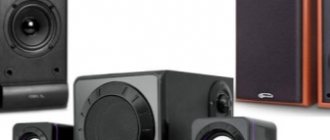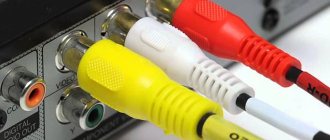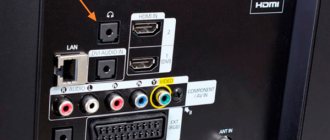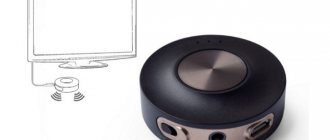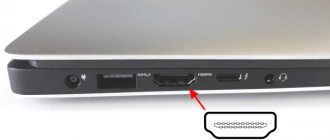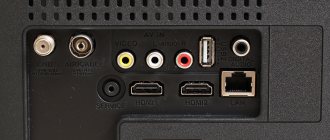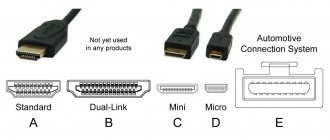There is no sound from the laptop through the HDMI of the computer
Author: w10w · Published 07/09/2018 · Updated 01/24/2021
One of the problems that you may encounter when connecting a laptop to a TV via an HDMI cable is the lack of sound on the TV (that is, it plays on the laptop or computer speakers, but not on the TV). Usually this problem is easily solved and further in the instructions - possible reasons for the fact that there is no sound via HDMI and how to fix them in Windows 10, 8 (8.1) and Windows 7.
Note: in some cases (and not very rarely), all the steps described below to solve the problem are not needed, and the whole issue is the sound reduced to zero (in the player in the OS or on the TV itself) or the Mute button accidentally pressed (possibly by a child) on the TV or receiver remote control, if used. Check these points, especially if everything was working properly yesterday.
Method 4. USB -> Multichannel Analog
Most of the Chinese “multi-channel USB audio cards” offered on the Internet are rather primitive dupes that produce processed stereo. You won't be able to save money.
Another thing is external audio cards. Some of them are capable of producing multi-channel audio and are suitable for connecting to tablets, laptops, and desktop computers.
Unfortunately, even Smart TV, not to mention most devices with proprietary firmware (receivers, media players)
will not be able to recognize it as an audio device. Therefore, Creative Sound Blaster Omni Surround 5.1, Creative X-Fi Surround 5.1 Pro or ST Lab M-330 USB are suitable only as computer accessories, or in the case of separate broadcasting of audio and video from a computer. And this is a completely different story.
Setting up Windows playback devices
Typically, when you connect a TV or separate monitor via HDMI to your laptop in Windows 10, 8 or Windows 7, audio automatically starts playing on it. However, there are exceptions when the playback device does not change automatically and remains the same. Here it is worth trying to check whether it is possible to manually select what the audio will be played on.
Most likely, these three steps will be enough to solve the problem. However, it may turn out that there is nothing similar to HDMI Audio in the list of playback devices (even if you right-click on an empty spot in the list and turn on the display of hidden and disabled devices), then the following solutions to the problem may help.
Installing drivers for HDMI audio
It is possible that you do not have drivers installed for audio output via HDMI, although the video card drivers are installed (this could happen if, when installing the drivers, you manually specified which components needed to be installed).
To check if this is your case, go to the Windows Device Manager (in all versions of the OS, you can do this by pressing the Win + R keys on the keyboard and entering devmgmt.msc, and in Windows 10 also from the right-click menu on the “Start” button) and open the “Sound, game and video devices” section. Next steps:
If only your sound card is in the list, then the solution to the problem will be as follows:
Note: If for one reason or another the drivers do not install, it may be due to some kind of glitch in the current drivers (and the sound problem is explained by the same thing). In this situation, you can try to completely remove the video card drivers and then install them again.
Source
How to output sound from a computer to a TV via HDMI?
In this article, I will show you how to switch the sound from the speakers of a laptop or desktop computer to a TV when connected via an HDMI cable. From my own experience, I can say that usually sound is output to the TV immediately after connecting an HDMI cable from a computer or laptop to it. But this doesn't always happen. Sometimes, after connecting the TV to the PC, the sound continues to be played through the speakers, or the speakers built into the laptop. This applies not only to TVs, but also to monitors with built-in speakers. In this case, you need to check the sound settings in Windows and change them if necessary. What are we going to do now?
First we need to connect our computer to the TV (if you have not already connected). To do this, turn off both devices and connect the cable to the HDMI output on the PC/laptop and to the DHMI input on the TV. We turn on the laptop and TV. Most likely, in the TV settings you will need to select the signal source (the port into which we connected the cable; this can usually be done with the INPUT button on the remote control). And on a laptop, you may need to change the image output mode to the second screen. This can be done through the menu, which is called up by the Win + P key combination. I will not show the entire connection process, since I already wrote about this in the article on how to connect a monitor to a laptop via HDMI. In the case of a TV and a desktop computer, everything will be exactly the same.
Well, as often happens, the image from the computer on the TV has fallen off, but the sound still comes from the built-in speakers in the laptop, or through speakers connected to the PC. Why this is so is unclear. But now let's try to figure it out and fix it.
Dear models
The most expensive models have extremely high requirements regarding sound, appearance and build quality. Moreover, their price is from 40,000 rubles and above.
Jamo S628 HCS
These are speakers designed to be installed on a TV. They belong to the premium class and their functions, quality and characteristics fully justify the high cost. The body is made of durable MDF material. Sound quality is achieved thanks to the presence of Bi-Wiring. This element allows you to hear all sounds in detail - the transmission of sound waves is so pure and clear. The front speakers are three-way, and the rear speakers are two-way.
Main characteristics:
- The power of the speakers in the set is different: the rear and center speakers have 80 W each, and the front speakers have as much as 150 W.
- Sensitivity – up to 87 dB.
- Playback frequency – 30-37 thousand Hz.
- The cost of the entire set is 65 thousand rubles and more.
Speaker system Jamo S628 HCS
KEF E305
The speakers are made in a creative design - they are round in shape. Due to their non-standard appearance, they can be used as an addition to the design of the room - this is an original decorative element.
The speakers have an unusually clear sound. And all because an aluminum diffuser is built into the system. There is also magnetic protection. These elements allow you to reproduce sound close to natural. There is virtually no distortion – it is reduced to a minimum. The system is passive in nature.
The system is installed mainly on shelves near the TV. Otherwise, you can attach it to the wall - the kit includes special racks.
Main characteristics:
- Sensitivity – 86 dB.
- Frequency – about 33–45 thousand Hz.
- Cost – from 88,000 rubles.
Speaker system KEF E305
Bose Acoustimass 10
Miniature speakers are distinguished by the fact that they demonstrate extraordinary power. In the manufacturer’s line, this model is considered one of the most powerful and durable. When played, it creates fullness and volume. The system is connected in spacious living rooms, large bedrooms or even public rooms. It is attached to the ceiling, so it does not take up any space in the room. Can also be installed on stands. The audio system is passive.
Main characteristics:
- The power of the rear and front speakers is 50 W.
- The speakers are designed as single-way speakers.
- Subwoofer – 200 W.
- Cost – from 90,000 rubles.
Speaker system Bose Acoustimass 10
Sonos Playbar
The system is intended only for watching films and videos. It is not suitable for music breaks or home discos. Installed on the wall or attached to the ceiling - as desired. The speakers can be controlled to increase or decrease the volume, and each of them can be adjusted individually.
It’s easy to use and set up the system: you can control it from the comfort of your couch through your smartphone by downloading a mobile application to it.
Main characteristics:
- High power and wide range of reproducible frequencies.
- There is support for Internet radio.
- The presence of a built-in Wi-Fi system that allows you to control the speakers via the Internet.
- Availability of digital optical output.
- Price – from 71,000 rubles.
Sonos Playbar Speaker System
How to switch audio to HDMI in Windows?
In Windows 10, Windows 8 and Windows 7, all these settings look approximately the same. Windows 10 has hidden the sound control panel a little. But it’s okay, we’ll find it!
Most often you need to manually change the default playback device. To do this, in Windows 7 and 8, right-click on the sound icon in the tray and select “Playback devices” . If you have Windows 10, then you also need to right-click on the sound icon, select “Open sound settings” and in a new window go to the old “Sound Control Panel” .
The list of playback devices should display the TV (LG, Samsung, Philips, Sony, etc.) to which our computer is connected via HDMI and to which we need to output sound. Right-click on the TV and select “Set as default” . This device may also be called “Digital Audio (HDMI)”, “AMD HDMI Output”, “AMD High Definition Audio Device”, “NVIDIA High Definition Audio Device”, etc.
What should I do if I can’t output sound from my computer to my TV via HDMI?
In addition to some experiments with replacing devices, cables, etc., you can apply several more solutions that may help solve the problem with sound output to the TV speakers.
I also had this problem: after connecting the TV to the computer, there is an image, but no sound. Almost always, this problem was solved by changing the default audio output device to HDMI. The second most effective solution is to remove the sound card from the device manager (namely, the HDMI device for displays).
Since the problem is very ambiguous and there can be a lot of solutions, I will be grateful if you don’t pass by and share useful information in the comments. Describe the solution that helped you display not only the picture, but also the sound on the big screen. Or just write which solution from the article helped you. Best wishes!
Source
Average price category
Prices vary from 10 to 40 thousand rubles. In terms of sound quality, these models are higher than budget ones and can satisfy discerning users.
Bose Acoustimass 5
One of the expensive representatives of the middle price category. It is possible to install it on a shelf or attach it to the wall.
Characteristics:
- 4-way compact speakers.
- Magnetic protection.
- Powerful drivers.
- Price – 40 thousand rubles.
Bose Acoustimass 5 speaker system
Pioneer S-ESR2TB
Floor-standing acoustics from a popular brand are of high quality. The body is made of MDF. The assembly of the case is perfect, the design is neat and stylish, thanks to which the system will fit into any interior. There are fasteners for floor mounting. The set includes 5 speakers: 2 rear and front, 1 center.
Characteristics:
- The sensitivity of the rear speakers is 81.5 dB.
- The sensitivity of the front ones is 83 dB, and the central ones are 88 dB.
- Frequency – 30-40 thousand Hz.
- The central element is two-lane.
- The front element is three-strip.
- Cost – from 21 thousand rubles.
Speaker system Pioneer S-ESR2TB
Harman Kardon HKTS 30
Accommodates an active subwoofer. Suitable for installation in home cinema. The design is modern, stylish, elegant - the glossy white shade attracts attention and complements the interior. It is the appearance that is the main difference between the system. But the sound quality is also excellent. Despite its compact size, the device disperses sound throughout the room. The system consists of 6 elements: 2 front and ceiling speakers plus 1 center, as well as a subwoofer to enhance the bass.
Characteristics:
- Playback frequency – 20–45 thousand Hz.
- Subwoofer power – 200 W.
- Sensitivity – 86 dB.
- Magnetic shielding.
- The price of the set is from 36 thousand rubles.
Acoustic system Harman Kardon HKTS 30
Stereo mixer in Windows 10: output audio to two devices simultaneously
Open the sound settings (by right-clicking on the corresponding icon in the tray) and go to the sound control panel.
In the “Sound” window, check that the “Speakers” device is in the “Default Device” status. If this is not the case, then right-click on them and select “Set as default”. Also note that I have a TV connected via HDMI displayed there (in my case it’s a monitor with built-in speakers, it doesn’t matter) and it’s in the “Ready” status.
Top 3 Xiaomi acoustics for TV
Home Cinema Xiaomi Mi Home Theater
The wireless connection via Bluetooth 4.1 will be smooth and free of interference. The panel has several connectors and ports (USB, HDMI, Ethernet, AV), and a Wi-Fi module.
High and low registers sound harmoniously, from the effect of real presence you enjoy music and watching a movie from the heart.
The speakers deliver powerful stereo sound using Dolby Audio and DTS-HD audio decoders.
Soundbar Xiaomi TV Soundbar (white)
Lightweight, compact attribute has low weight and minimalist body design. Speakers in the amount of 8 pcs. protected from dust by material that resembles eye-catching denim.
The side panel has a clear connection interface with indicators. Playback and listening are convenient at a maximum distance of up to 10 m. The sound is clear and spacious.
Additional stereo mixer settings
There in the stereo mixer settings there are several more tabs with additional settings. Let's see what can be configured there and whether it needs to be done. I’ll say right away that I didn’t find anything interesting or useful there.
By opening the Levels tab, you can change the volume on the device to which audio is output through the stereo mixer. You can also turn off the sound and change the balance.
Well, there’s the “Advanced” tab, where you can adjust the bit depth and sampling frequency (these settings are not active for me) and configure the exclusive mode. It is better not to touch these settings. Although in my case, they did not affect anything. At least I didn't notice anything.
Why is there no sound via HDMI on the TV when connecting a laptop (PC) on Windows 7 and Windows 10
I have already prepared several instructions for connecting a TV to a computer via an HDMI cable, and I noticed that there is one very popular problem that many people face. The problem is that after connecting the TV to a computer or laptop, there is no sound on the TV. That is, the sound is not played through the HDMI cable, but continues to sound from the laptop speakers or speaker system.
We know that sound is transmitted through an HDMI cable. This means it should sound from the TV speakers. And as a rule, the sound on a TV is much better and higher quality than on the same laptop. Therefore, it makes sense to still configure the sound via an HDMI cable on the TV. When I wrote the connection instructions, I myself encountered a problem when there was no sound on the TV. But this problem can be solved very simply. You just need to change some settings on your laptop or PC. Moreover, in Windows 7 and Windows 10 these settings are almost the same.
I’ll immediately provide links to detailed articles on connecting a TV via HDMI:
By the way, in these articles, I wrote about problems with sound. Everything is described there in detail. One article uses Windows 7 as an example, and the second uses Windows 10 as an example.
Method 2. (Digital) Optical -> Multichannel Analog
This is why this article was started. I often get asked questions like: “How do I connect my home theater to my new TV? It doesn't have analog audio outputs!
Mine only has a two-channel mini-jack and optical Toslink. For the time being before purchasing new acoustics, I connected the old 5.1 set using this Chinese converter.
Hidden inside the device is a rather primitive digital-to-analog converter and DSP processor.
— a chip responsible for mixing, equalizing and effects.
The application is very simple - we connect an acoustic system to the analog RCA outputs, on the other hand we supply an audio signal through a coaxial or optical connector and external power from the included power supply.
If the signal corresponds to the number of connected acoustic channels, it passes without mixing and processing. As it is.
That is, if the film has a 5.1 channel audio track
, and we use the appropriate audio system - the sound quality will be the same as the original.
If a two-channel track is fed to it, then the signal is converted using “virtual” mixing in the processor and distributed to all speakers.
Of course, this is very different from real 5.1-channel sound, but still, it sounds nicer than regular stereo. Unless, of course, we are talking about films.
This way you can connect the speakers to other devices
- for example, through the usual headphone output of a laptop, tablet or player.
But the output will only be virtual 5.1-channel sound, even if the original track is multi-channel. You won't be able to get anything else out of the stereo jack.
If necessary, the converter allows you to reproduce any incoming audio signal into two channels. Convenient for 2.1
, as well as in cases where the DSP converter plays the track incorrectly.
Setting up HDMI audio for a TV in Windows 7 and Windows 10
In Windows 10, these settings look exactly the same.
Connect your computer to your TV using an HDMI cable. Select the desired HDMI input on the TV as a source so that the image from the computer appears. Check to see if the TV itself is twisted or muted.
Next, on your computer, right-click on the sound control icon in the notification panel. Select "Playback devices" .
The parameters will not differ further.
In a new window, in the list of available devices, you will see your TV or “Digital Audio (HDMI)” device. For example, I have Philips. It may say LG, Samsung, Sony, etc. Right-click on it and select “Set as default” .
That's it, the sound will work on the TV. The device we select will be used by default. Click Ok to close the window.
As you can see, you just needed to change the playback device, and the sound immediately started coming from the TV. In the same way, you can switch back to the laptop speakers or speakers. After disconnecting the HDMI cable, audio will automatically be output from the speakers. And when you reconnect the TV, the sound itself will work via HDMI.
If you need to simultaneously output sound to your computer speakers and TV speakers , you can try setting everything up according to these instructions.
Purpose and equipment of a home theater
A home theater is a whole set of equipment designed for high-quality video and sound transmission. Such a cinema hall allows you to organize a full-fledged entertainment area in your living space.
The main purpose of a cinema is to create and enhance the effect of presence for the viewer. The number of functions of the entire system is determined by its configuration and the capabilities of individual devices.
set of home cinema includes the following equipment:
- playback device (signal source);
- receiver;
- screen (display device);
- acoustic system.
The system may also include power amplifiers and various stands (stands). All equipment is connected to each other using wires and cables. Acoustics are represented by speakers and a subwoofer.
Each device in the system performs a specific role. Only when fully equipped do the cinema's functionality reach its maximum.
Checking the High Definition Audio Controller (Microsoft, AMD, NVIDIA, Intel)
The problem turned out to be the High Definition Audio controller (Microsoft), which for some reason was disabled in the device manager.
Therefore, go to the device manager, open the “System devices” , find there “High Definition Audio Controller (Microsoft)” and see if there are any icons next to it. If there is, right-click and try to turn it on.
You can also open properties and see if this device is working normally. As a last resort, you can disable it, restart the computer and turn it on again. I don't recommend deleting it. There is no guarantee that it will be installed automatically after a reboot. You can remain without sound at all. Not only via HDMI.
Also check the “Sound, game and video devices” . There may be an "NVIDIA High Definition Audio" or AMD adapter. This already depends on the installed video card.
For example, my monitor with speakers connected via HDMI is displayed on the “Audio inputs and audio outputs” . Be sure to check out this tab. Maybe it displays a TV that is connected via HDMI and to which no sound is output. In my case, it's "Intel Audio for Displays".
So be sure to check these three sections in the device manager. Maybe you really have some kind of adapter disabled and because of this all the problems with sound on the TV or monitor.
Update: The cable is connected to the HDMI (DVI) v1.3 port, through which no sound is transmitted
Usually, near the HDMI input on the TV, in addition to the port number, additional information is indicated in brackets (DVI, STB, ARC, MHL). In most cases, these ports differ in some functionality. But that’s not about that now. We are interested in the HDMI (DVI) port. This port is designed for connecting computers and laptops when the TV acts as a monitor, where sound output does not seem to be needed.
So, if your TV has an HDMI (DVI) port version 1.3 and you connect a computer to this port, then no sound will be output! In HDMI version 1.4, this port already received support for audio output.
I thought that this might be the cause of the problem that this article aims to solve. Especially on older TVs. Connect the cable to a different port. Which is simply labeled HDMI IN, or HDMI (STB).
Update: enable display of disabled and disconnected devices
The comments suggested another way. Open "Playback Devices", and right-click on an empty area in the window. Check the boxes next to two items: “Show disconnected devices” and “Show disconnected devices.”
Update: driver reinstallation
In the comments, Vitaly recommended a method that helped him solve this problem. And judging by the reviews, it helped not only him.
The idea is to update the driver (video, audio) through the DriverPack Solution program with a TV connected via HDMI. To be honest, I am against these programs. They can slip in such a driver that you won’t be able to clean it up later. But if this helps, and people write that everything works, then I decided to add this method to the article.
Update: remove the sound card in Device Manager
Another tip from the comments. I haven’t tested this myself, but there are reviews that the method works.
How to output sound via HDMI: away with unnecessary wires
The fewer cables the better, and it’s hard to argue with that. HDMI is a universal interface that can not only transmit high-quality images, but also output sound. This allows you to reduce the number of wires, because instead of a pair of cables (for audio and video), one universal one is enough. And if you consider that there are plenty of ready-made HDMIs, several meters long, on sale, and a long cable with two audio connectors will have to be soldered yourself, this also saves time.
It would seem that outputting sound via HDMI is not a difficult task, but it also has its own nuances. Not always, after connecting the wire, not only the picture, but also the sound begins to be broadcast. In some cases, this requires some more effort.
How to output audio via HDMI on new PCs
From a computer that was released not very long ago (no more than 3-5 years ago), outputting sound via HDMI is quite simple. You need to connect the cable at one end to a TV or monitor equipped with speakers (or a 3.5 mm jack for connecting speakers/headphones), and at the other end to the picture source (PC video card, or pins on the motherboard if integrated graphics). The picture will be transmitted immediately, but with sound it’s a little more difficult.
Modern video cards are equipped not only with a graphics processor, but also with a sound processor. It is designed specifically to output sound via an HDMI cable. You can see if your computer has a second sound card (built into the video card) in Device Manager. To get into it, you need to right-click on the computer icon on the desktop and find this item in the left column of the window that opens, or simply enter the search in the Start menu.
In order for sound to be output via HDMI without additional devices, the system must display at least two audio devices. One of them is built into the motherboard, the second is built into the video card. The exception is motherboards equipped with an HDMI output (if graphics integrated into the processor are used): they can have one sound device, and the audio outputs of the HDMI connector are connected to it.
On a computer with a video card integrated into the processor, the procedure is simple. Before outputting sound, the HDMI cable only needs to be connected to the monitor/TV and to the connector on the back of the board.
How to configure audio via HDMI on AMD video cards
To output audio via HDMI to a PC that has AMD Radeon discrete graphics installed, you will also have to dig a little into the settings. To do this, you need to launch the “Control Panel” and find the “Sound” submenu there, or simply enter this request into the “Start” menu.
To output sound through the HDMI connector of the video card, you should select the sound processor of the video card (AMD Audio) and click the “Default” button on it. If two screens are connected to the PC in parallel in picture duplication mode, this is not necessary (everything switches automatically).
The disadvantage of this solution is that when audio is output from a discrete video card, the audio connectors on the front panel of the system unit stop working. To fix it, you need to open Radeon Settings (usually the icon is located on the right side of the taskbar, next to the network status, clock and language).
In the menu that opens, you need to open the “Settings” submenu, select “Advanced settings” and find the “Sound” tab on the left. Then you need to connect headphones or speakers to the jack on the front panel. In the additional settings window, find the output corresponding to the sockets on the panel (if headphones are connected, it will be colored), right-click and select “Set as default” and click the “Apply” button.
Now, when the front connector is connected, sound will be sent to it, and when disconnected, it will be sent to the monitor/TV.
This disadvantage is not present on laptops, just as it is not present on PCs with integrated graphics.
Budget options
Budget models are those that cost less than 10,000 rubles. They sound good at home. They can be used to watch movies and listen to music.
SVEN HT-210
This is a small-sized acoustic system from a Finnish manufacturer. Its format is 5.1. Its design includes a subwoofer and 5 satellites. The kit includes fasteners intended for the wall, as well as a wire for connection, 4 speakers - 2 front and 2 rear, and a center channel.
Characteristics:
- The power of the central speaker is 15 W.
- Playback frequency 40-20 thousand Hz.
- Subwoofer power – 50 W.
- The body is one-piece, closed type.
- Memory card slot.
- Active type of acoustics.
- Price – from 8 thousand rubles.
Acoustic system SVEN HT-210
BBK MA-970S
The model includes a decoder that allows you to change stereophonic sound, converting it into multi-channel. At the same time, its dimensions are impressive. Accommodates front and center speakers and a subwoofer. The loudspeakers are made of MDF. There is a drawback: the connection cable is very short, so you will either have to install the speaker very close to the TV or buy a new one.
Characteristics:
- Power – 40 W.
- Playback frequency – 20,000 Hz.
- Subwoofer – 80 W.
- Cost – from 9,500 rubles.
Speaker system BBK MA-970S
Yamaha NS-P60
The kit includes a central speaker and two rear speakers. Used in multi-channel systems. Designed to be mounted on a shelf, or wall mountable. Two-way speakers have magnetic protection. The body is made of high quality MDF material. Passive type. All parts are compact and take up minimal space.
Characteristics:
- Sensitivity – front 90 dB, rear 91 dB.
- Frequency – 30-80 thousand Hz.
- Price – from 8 thousand rubles.
Speaker system Yamaha NS-P60

